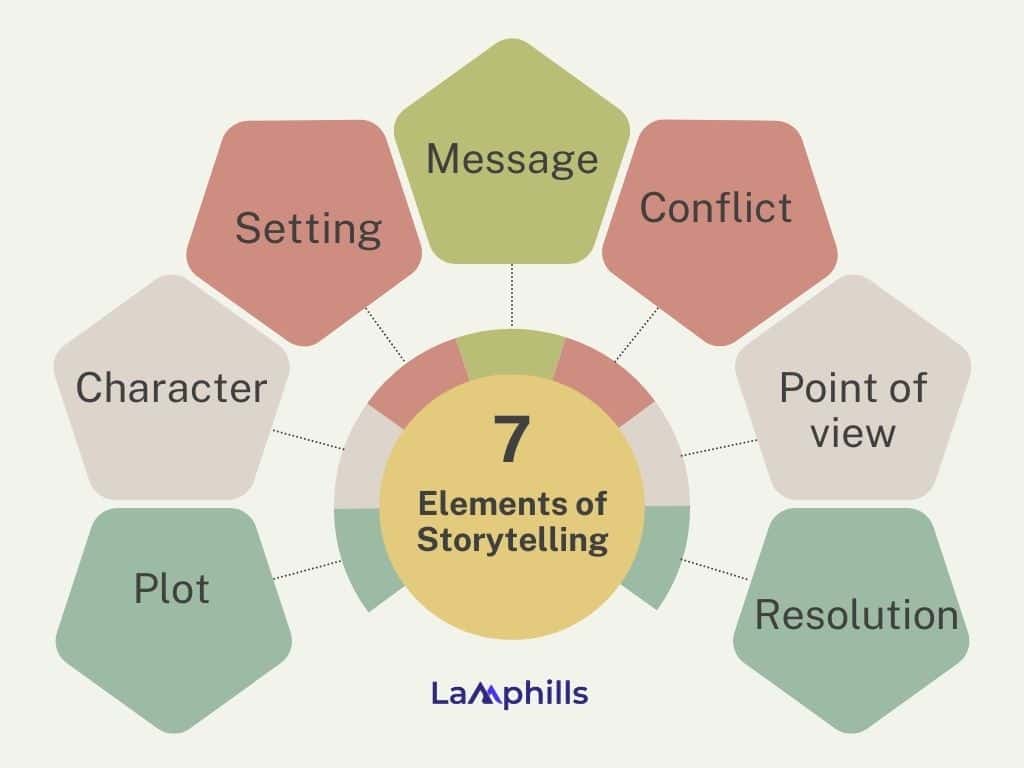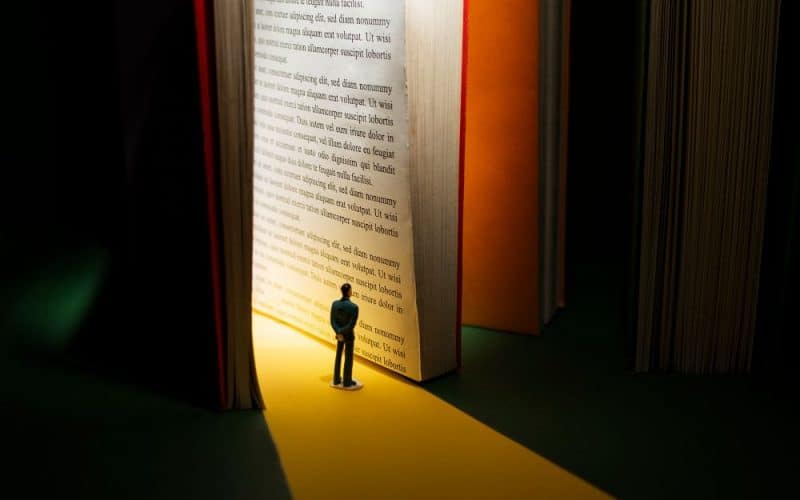Before I ventured into public relations and digital marketing, I was a content creator. And not just a digital content creator, I was a storyteller. Sitting down, staring into space for hours on end while crafting scenarios in my head, then doing my best to translate them into words… that was me. Storytelling was my gig, and I had to adopt certain elements for it.
A well-crafted story typically consists of multiple elements working together to engage the reader or audience. They inform and entertain the readers, and convey the writer’s intended message or purpose.
Now, while the significance of each element may vary depending on the objective of the story, if you’re looking to write to connect with your audience, there is a general checklist that you can use to ensure you’re on the right track to doing so.
Key Points
- Storytelling is the process by which a story is shared or told.
- Elements of storytelling include plot, characters, setting, message, conflict, resolution and craft.
- Plot involves structuring your story to elicit specific emotional responses from the people hearing it.
- The characters are who is involved in your story—who the plot is happening to. They drive the story and plot by facing conflict.
- The setting is the time and place where the story occurs. The time and location of the story can influence several additional elements of a story.
- The message or theme is what makes your story bigger and more universal than just the series of events.
- Conflict is what happens in your story that gets in the way of your main character. It adds tension and suspense.
- The POV you choose can help shape your entire story. There are several different POVs to consider, but the most common are first-person, second-person, and third-person.
- Your resolution, also sometimes called a denouement, is how you wrap up your story. A story without a resolution is just frustrating and unsatisfying.
- Craft is how you bring all your elements together. It’s your word-by-word, sentence-by-sentence level writing.
What is Storytelling?
Storytelling is the process by which a story is shared or told. It is an ancient art form that involves the presentation and delivery of a narrative, revealing the elements, images and events of a story whilst encouraging the imagination of the audience.
Elements of Storytelling
There are numerous elements involved with storytelling. You could see as few as five elements, or even as much as fifteen, but at the end of the day, you have to adopt what works for you.
For me, I managed to narrow mine down to sevel essential elements that have served me well in my storytelling journey. These are:

#1. Plot
Put simply, the plot is what happens in a story. Plot is one of the most key elements of storytelling—in fact, story and plot may seem like one in the same. But, as author Barbara Vance shares in her Skillshare class, there’s actually an important distinction: While a story is simply the linear events as they happened, “plot is the sequence of events as you have designed them for the reader.”
Plot involves structuring your story to elicit specific emotional responses from the people hearing it, which can involve rearranging the order of events, withholding information until just the right moment, or using other plot devices used to create more interesting narratives.
“Plot is manipulative,” Vance explains. “You are tweaking the story.” She suggests asking yourself: “How do I take the sequence of events that I have in my head and make it as suspenseful, as engaging, as emotionally gravitational as possible?”
For instance, Hamilton starts by telling us about all the things that Alexander Hamilton will eventually achieve—and even spoiling the fact that he will be shot in the end—to make the audience want to understand how he gets there.
To keep your reader engaged and interested, your story should include these plot elements:
Exposition
Exposition gives the reader the background info they need to jump right into your story’s world. This is often found towards the beginning of your story. Even if you choose to jump right into the action, somewhere along the way your reader needs to get a crash course on your characters’ or setting’s history.
Exposition can be given in a variety of ways. Some examples include:
- Flashbacks
- Character dialogue
- Letters from the past
- Setting or character descriptions
- Point of View (aka POV, such as the narrator or main character’s thoughts)
However, in the words of Officer Lockstock in the Tony award-winning Urinetown: The Musical, “nothin’ can kill a show like too much exposition.” This rings true whether you’re watching a play or reading a story. Don’t overload the reader with background info right out of the gate. Keep it natural and let it drive the story forward rather than stalling it while everyone catches up.
Look to great worldbuilding novels, such as Lord of the Rings or Hunger Games, for excellent examples of setting the stage. These worlds were built from the ground up, but as a reader, I never felt labored under the weight of all that information. Find the common ground between your story’s world and the reader’s and work from there, cluing them into the big differences as you go.
Rising Action
The rising action is the moments in your story that lead up to the climax — choices your main characters have made and the events happening that are at odds with your characters’ goals. This is where your story builds and your reader begins to invest in your characters.
This is likely going to be the longest section of your story. A whole lot happens between the start of the novel and that moment, but often you’ll find yourself holding your breath and waiting to see what will happen. That is the power of rising action.
Climax
This is it — the primary turning point and what your story has been building towards. What are your main characters going to do? Will they succeed or fail?
Typical climaxes include victories or defeats. The main goal of the climax is to resolve the conflict, but whether that positively or negatively affects your character is up to you. Or maybe it’s not that simple.
Falling Action
Now that the main conflict is resolved, it’s time to begin wrapping everything up. The falling action is a great time to tie up any loose ends while also giving your characters a chance to deal with the aftermath of the climax.
Resolution
It’s time to end your tale! If you still have unanswered questions in your plot, answer them now. The resolution is also the time to show the next step in your characters’ lives. Do they live happily ever after? Is a new era dawning? Or do they just continue on with their ordinary existence with a new experience under their belt?
The resolution of one story can also be the start of another. You can introduce a new conflict or raise more questions for your reader.
#2. Characters
The characters are who is involved in your story—who the plot is happening to. Many people would argue that creating interesting characters is one of the most important elements of good storytelling. Because, think about it, most of the time that you’ve not enjoyed a story, it was because you didn’t care that much about the characters.
Good stories have multiple characters, but the main ones are:
- Protagonist. The protagonist is typically the ‘good guy’ in your story — the one the reader is rooting for. This main character is super important and central to your plot. They are often trying to overcome the conflict while finding themselves at odds with our next character type.
- Antagonist. The antagonist of your story doesn’t have to be a single person. It can be any character, group, or force that is at odds with your protagonist. This doesn’t mean they have to be ‘evil’ or the ‘bad guy’, but the antagonist is often pushing the conflict onto our protagonist.
Your story can also have other types of characters like:
- A confidant: the sidekick or best friend
- A foil: the opposite of the protagonist, who exists to bring the protagonist’s qualities out
- Other secondary or tertiary characters that drive the story forward, or fill in details of the story
Characters drive the story and plot because they face the conflict thrust upon them (or the conflict they choose to take on). They each need to have:
- Distinct personalities
- Motivations
- And internal and external arcs
How To Create Compelling Characters
The best characters are flawed. And through the story, we see how those flaws help or restrict them from prevailing over the conflicts they face. I have learnt that there are two critical aspects of character building, which are especially important for your primary characters. You have to understand and believe in their humanity to the point that you care about them on some level, and they have to want something.
The first point is all about making interesting characters. It doesn’t mean the reader has to like them, but they have to want to know more. Joe Abercrombie’s First Law series is one of my favorite books ever, and there is not one good soul in there. Almost everyone is morally grey, yet they feel so real that you can’t help but root for them in certain situations even when you know they don’t deserve to live. The second is all about making sure your characters have a driving motivation.
The characters have to be alive. Plain and simple.
#3. Setting
The setting is the last of the three elements of storytelling that must exist for a story to even be a story. The setting is where your story is happening, the world it is in. At its most basic, your setting should involve painting vivid scenes of the places where your story is taking place using the descriptive writing style.
- Where does the story take place?
- Where do the characters live?
- What is their ordinary world before they face the conflict?
- Where does the plot take them to resolve the conflicts within the story?
The setting is the time and place where the story occurs. The time and location of the story can influence several additional elements of a story:
- Mood
- Atmosphere
- Tone
- Character Types
Your story’s world may just be in the space of a room, but you still need to understand the kind of room they’re in, and who else is in it, and what it looks like, and what matters about that room. What are the experiential levels of being in this place, the sounds and the smells? What do you see, and what do you feel when you’re here?
However, the setting should also include other information about how the world your characters are in works, which is known as the context. While this is especially true when you’re building new worlds for fantasy or fictional stories, it can also be important information in non-fiction. What are the societal dynamics you need to understand about this place? Who has the power? How do your characters feel about the place that they’re in?
Without all of these, it feels like your characters are in a void.
#4. Message
The four P’s of storytelling—one device people use to remember what needs to be included in a story—adds an additional critical element: plot, people, places, and purpose. Why are you telling this story? What are you trying to convey?
While your purpose could be simply to entertain with a funny anecdote, usually the purpose takes the form of a moral or message. Fables and fairy tales are especially known for being on the nose with their messages (e.g., The Boy Who Cried Wolf is all about the repercussions of lying). It can also take the form of a higher-level theme you are exploring, without having a specific stance you’re trying to get across about the subject: Star Wars is consistently exploring good vs. evil. Hamilton is about legacy. Little Women about coming of age.
Ultimately, the message or theme is what makes your story bigger and more universal than just the series of events. It’s what turns a plot into something that really sticks with readers and makes them think, and it should be interwoven throughout your story.
#5. Conflict
Among the elements of storytelling and character development, conflict is everything. It is what happens in your story that gets in the way of your main character. It’s one of the most important elements of good storytelling because it adds tension and suspense, making the audience want to keep listening to find out what happens.
Without it, the narrative lacks the journey essential for the character’s transformation. A character’s growth occurs during the story’s progression, and this metamorphosis comes to life primarily through their actions and reactions when faced with adversity (conflict).
Think about it this way: Nobody wants to hear a story where everything goes right, nothing surprising happens, and nothing has to be overcome. You need to create bumps in the road for your character so the audience will be unsure how everything is going to turn out in the end.
There are two kinds of conflict that can be woven into your story: internal and external. Internal conflict is going to be what the characters are going through within themselves, what they have to overcome to get what they want, to get their desire which has been fueling them for the story. The external conflict is whatever outside of them stands in their way in the world.
There are different types of conflicts you may choose to use, but the most common are:
Character vs Self
In this type of conflict, your main character must overcome something within themselves to achieve their goal. These internal conflicts may look like doubt, fear, or grudge. It’s whatever is holding them back from their desires.
The Lord of the Rings provides a great example of character vs self with Aragorn. He is destined to be king, but his own doubts have taken him away from that path. One of the major plots of the story is Aragorn realizing that he is capable and worthy of this leadership role.
Character vs Character
In a character vs character conflict, someone is standing in our protagonist’s way. This is a very common conflict type in superhero tales. There’s a ‘bad guy’ our main characters must defeat before the story ends.
Character vs Nature
Character vs nature conflicts pit our characters against some kind of natural force. It could be a natural disaster (tornado, hurricane, wildfire, avalanche) or any other kind of survival tale. Many post-apocalyptic stories involve both character vs nature and character vs character conflicts.
Another example of character vs nature is when our characters are battling forces of nature, such as in The Fault in Our Stars by John Green. In this heartbreaking story, two teens are fighting cancer diagnoses — a force of nature they have no control over. After falling in love, they are then left to battle time and death — two other powerful forces of nature.
Character vs Society
In our final conflict type, characters are battling oppressive societal norms. In character vs society, our protagonist feels like they are at odds with the whole world. This can often be broken down into character vs character to get a strong emotional pull (such as a kid at odd with their parents) but the themes are much bigger than any one person.
#6. Point of View
The POV you choose can help shape your entire story. There are several different POVs to consider, but the most common are first-person, second-person, and third-person.
First-Person Point of View
A story told in the first person is most often told from the point of view of the protagonist. Our protagonist narrator will speak using first-person pronouns (I, we, me, etc). And as the reader, we are privy to their innermost thoughts and feelings.
This is a great way to pull a reader into the story, and a very strong bond can be formed between the reader and the narrator. The readers never know more than the protagonist does about what is happening, leading to some great surprises and reveals as the story continues to unfold.
Second-Person Point of View
You won’t see second-person POV used very often in literature, but it is an important POV to keep in mind. In the second person, the reader is addressed directly and may even become a character of sorts in your story. This point of view is written using second-person pronouns (you, your, etc).
Though you can find some books written in the second person, most often you will see this writing in your digital reading, such as ads and blog posts — why, hello there!
Third-Person Point of View
Third-person POV is by far the most common point of view in fiction writing. In this kind of story, the reader is a bystander, observing the actions of the characters as told by an ‘outside narrator’. This POV used third-person pronouns (he, she, they, etc). However, how much we learn as a reader depends on which style of narrator you choose.
Third-Person Omniscient
A third-person omniscient narrator knows everything going down in the story. As a reader, we can learn the inside thoughts and feelings of all the main characters. The story unfolds in front of us, and we get to experience it through a variety of character lenses.
Third-Person Limited
In this POV, our narrator has access to only one character’s inside thoughts and feelings. As the reader, we typically follow this one character as our main character, learning only what they know and seeing the world through their eyes and experiences.
#7. Resolution
Of course, once you create conflict, you don’t want to leave the audience hanging: you want to make sure your story also has a resolution, also sometimes called a denouement. A story without a resolution is just frustrating and unsatisfying.
While very often resolutions take the form of a “happily ever after” ending where everything works out, it doesn’t always have to be that way. You could decide not to give your character what they want and have them learn a lesson. Or to give them what they want but have them realize it’s not really what they wanted all along. Often, how you choose to resolve your story could tie into the message you’re trying to convey.
In Romeo and Juliet both the protagonists die at the end, showing Shakespeare’s feelings about the deep, long-lasting wounds that feuds can cause.
There are so many options for how you wrap up a story but, whatever you do, make sure not to leave your readers or listeners hanging.
Bonus: Craft
Now, this may be subjective, but I’ve learned that perhaps one of the most overlooked elements of good storytelling is craft—or how you bring all of the above elements together. It’s your word-by-word, sentence-by-sentence level writing. Craft holds it all together.
You can have a great conflict with cool characters and awesome world-building, but if you can’t write a good sentence, your readers will not make it past page one.
While, yes, craft can involve poetic, beautiful language or especially clever writing, you should start by making sure your story is clear and doesn’t have any confusing errors or writing that’s hard to muddle through.
Now, how do you improve your craft? For me, I do this by reading my story out loud. This will help you catch, first of all, really dumb mistakes. Second of all, really awkward sentences. Third of all, stuff that just doesn’t make any sense. That’s what you need to be on the lookout for.
Elements of Storytelling: In Conclusion
A good story can be thought of in the same way as a good meal, not only is it both rewarding and nourishing, but it’s also only as good as the sum of its parts. If we were to illustrate the essential elements of storytelling as the essential elements of a decent meal, it could look like this:
- The message of your story could be the purpose of your meal, why are you making this particular meal and how does it benefit those you’re serving it to?
- You could equate your characters to your ingredients and your plot to your cooking techniques; the way you cook your ingredients will affect how they turn out, and applying different techniques to the same ingredients will have different results.
- Your setting is the way you decide to present your meal and presentation is always an important aspect of a meal; imagine serving soup on a plate or a sandwich in a bowl.
- You’ll need some kind of tools in order to prepare a good meal and that’s where your conflict comes in, without the right tools your meal will just be food.
- As for craft, well, that needs no metaphor; craft is translatable across both storytelling and cooking, and without craft, neither will turn out well.
The essential elements of storytelling are called essential not just because they need to be a part of the story, but because they are a necessary feature that should play a prominent role in your story. Without them, you have no story.
Recommended Articles
- Content Team: How to Build & Grow an Effective Content Team
- How To Measure Reach: Effective Tools and Strategies
- What Is Creative Content? All You Need 2024
- Creative Writer: Who Is It & How to Become One in Nigeria 2024
- How Much Do Social Media Influencers Make? Income Breakdown
- Content Development Best Practices for Higher Engagement






